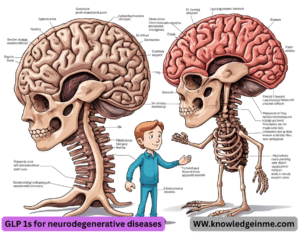GLP 1s for neurodegenerative diseases GLP-1 receptor agonists (GLP-1 RAs), originally developed for type 2 diabetes and obesity, are now being investigated for their potential neuroprotective effects in neurodegenerative diseases, including Alzheimer’s disease (AD), Parkinson’s disease (PD), and others. Here’s an overview of the evidence and mechanisms:
Potential Mechanisms of GLP-1 in Neurodegeneration
Anti-inflammatory Effects
- GLP-1 reduces neuroinflammation by inhibiting microglial activation and pro-inflammatory cytokines (e.g., TNF-α, IL-6).
Reduction of Oxidative Stress
- GLP-1 RAs enhance antioxidant defenses, reducing oxidative damage to neurons.
Improved Insulin Signaling & Glucose Metabolism
- Insulin resistance is linked to neurodegeneration (“Type 3 diabetes” hypothesis in AD).
- GLP-1 improves brain insulin sensitivity, promoting neuronal survival.
Amyloid & Tau Modulation (in Alzheimer’s)
- GLP-1 RAs may reduce amyloid-β (Aβ) plaque formation and tau hyperphosphorylation.
Neurogenesis & Synaptic Plasticity
GLP-1 promotes neurogenesis (e.g., in the hippocampus) and enhances synaptic function.
Mitochondrial Protection
- GLP-1 improves mitochondrial function, critical in PD where mitochondrial dysfunction is prominent.
Clinical Evidence
Alzheimer’s Disease (AD)
- Liraglutide (Victoza) & SEMAGLUTIDE (OZEMPIC) have shown promise in preclinical models.
- ELAD trial (Liraglutide in AD): Suggested potential cognitive benefits, though larger trials are needed.
- EVOKE trial (SEMAGLUTIDE in AD): Ongoing phase 3 study (NCT04777409) assessing cognitive outcomes.
Parkinson’s Disease PD
Exenatide (Byetta/Bydureon):
- Phase 2 trials showed motor and cognitive improvements in PD patients.
- Long-term follow-up suggested sustained benefits (NCT01971242).
- Lixisenatide (Adlyxin): A 2024 NEJM study reported reduced motor decline in PD patients.
Other Neurodegenerative Conditions
- Huntington’s disease, ALS, and MS are also being explored, though evidence is preliminary.
Challenges & Future Directions
- Blood-brain barrier (BBB) penetration: Not all GLP-1 RAs cross the BBB efficiently.
- Optimal dosing & long-term effects: More clinical trials are needed.
- Dual/triple agonists (e.g., GLP-1/GIP/glucagon): May offer enhanced neuroprotection.
Clinical Trials Breakdown
Alzheimer’s Disease (AD)
- ELAD Trial (Liraglutide)
- Design: 12-month, randomized, placebo-controlled in mild AD.
- Results: Trend toward reduced brain atrophy; no significant cognitive decline.
- Limitation: Small sample size (N=204).
- EVOKE (SEMAGLUTIDE , Phase 3)
- Status: Ongoing (results expected 2025-2026).
- Hypothesis: SEMAGLUTIDE may slow cognitive decline via amyloid-independent mechanisms.
Parkinson’s Disease PD
Exenatide in PD (2017, 2020 Follow-up)
- Results: 48-week trial showed improved motor scores (MDS-UPDRS) vs. placebo.
- *2020 Follow-up*: Benefits persisted 12 months after stopping treatment.
- Mechanism: Possible mitochondrial protection in dopaminergic neurons.
Lixisenatide in PD (2024 NEJM Study)
- Results: 12-month trial (N=156) showed ~50% reduction in motor decline.
Other Diseases
- Huntington’s (HD): Preclinical data show liraglutide reduces mutant huntingtin aggregation.
- ALS: Exenatide trials planned (mechanism: anti-inflammatory + metabolic support).
Molecular Mechanisms Detailed
Anti-Amyloid & Anti-Tau (AD)
- GLP-1 RAs activate PKA/CREB pathways, reducing:
- Aβ production (via inhibition of BACE1).
- Tau phosphorylation (via GSK-3β inhibition).
Dopaminergic Neuron Survival (PD)
- Exenatide upregulates:
- Brain-derived neurotrophic factor (BDNF).
- Autophagy (clearance of α-synuclein aggregates).
Neuroinflammation
- GLP-1 inhibits NF-κB and NLRP3 inflammasome → reduces IL-1β, TNF-α.
Insulin Sensitization
- Rescues brain insulin resistance (AD brains show ~80% lower insulin receptor sensitivity).
Challenges & Limitations
- BBB Penetration: Liraglutide/SEMAGLUTIDE cross weakly; exenatide/lixisenatide may perform better.
- Weight Loss Confounder: GLP-1 RAs cause weight loss; could this worsen cachexia in late-stage PD/AD?
- Trial Design: Most studies are short-term (12-18 months); neurodegeneration requires longer follow-up.
Future Directions
- Dual/Triple Agonists (e.g., retatrutide = GLP-1/GIP/glucagon): May enhance neuroprotection.
- Combination Therapies: GLP-1 RAs + anti-amyloid (e.g., lecanemab) or α-synuclein-targeting drugs.
- Biomarkers: Using PET scans to track amyloid/tau changes in AD trials.
Dosing Protocols from Major Trials
Parkinson’s Disease
- Exenatide (Bydureon):
- Loading Phase: 2 mg subcutaneous weekly × 12 weeks.
- Maintenance: 2 mg/week for 48 weeks (total 60 weeks).
- Result: 3.5-point improvement in MDS-UPDRS Part III (vs. placebo decline).
Lixisenatide (Adlyxin):
10 mcg/day × 2 weeks → 20 mcg/day × 50 weeks.
Alzheimer’s Disease
- Liraglutide (ELAD Trial):
- 0.6 mg/day × 1 week → 1.2 mg/day × 1 week → 1.8 mg/day × 50 weeks.
- Outcome: No cognitive decline, but no significant improvement vs. placebo.
SEMAGLUTIDE (EVOKE Trial):
Emerging Research & Novel Mechanisms
Beyond Amyloid/Tau: Synaptic Rescue
- GLP-1 RAs increase postsynaptic density protein-95 (PSD-95) and synaptophysin in hippocampal neurons, reversing synaptic loss in AD models.
Gut-Brain Axis Modulation
- Microbiome interaction: GLP-1 RAs alter gut microbiota (↑ Akkermansia, ↓ Proteobacteria), reducing systemic inflammation linked to neurodegeneration.
Autophagy Boost in PD
- Exenatide activates TFEB (lysosomal transcription factor), enhancing clearance of α-synuclein oligomers.
Vascular Protection
- GLP-1 RAs reduce cerebral amyloid angiopathy (CAA) by 40% in AD mouse models via VEGF stabilization.
Controversies & Unanswered Questions
Weight Loss: Help or Harm?
- Pros: Obesity worsens neurodegeneration; GLP-1-induced weight loss may be beneficial.
- Cons: Cachexia is a late-stage PD/AD concern; trials exclude underweight patients.
Do GLP-1 RAs Work in Late-Stage Disease?
Most trials focus on early PD/mild AD; animal data suggest limited efficacy in advanced pathology.
Sex Differences
- Women show better response in AD trials (possibly due to estrogen-GLP-1 interactions).
Cost & Access
- Off-label use for neurodegeneration costs $800-$1,300/month (vs. $25/month for levodopa).
Next-Generation Agents in Pipeline
Oral GLP-1 RAs
- Oral SEMAGLUTIDE (Rybelsus): Phase 2 trial for AD planned (2025).
- Danuglipron (PF-06882961): First non-peptide oral GLP-1 RA; may have better CNS penetration.
Dual/Triple Agonists
- Retatrutide (GLP-1/GIP/Glucagon): Preclinical data show superior neurogenesis vs. SEMAGLUTIDE .
- NN6535 (GLP-1/Amylin): Targets both insulin resistance and amyloidosis.
Practical Considerations for Clinicians
Who Might Benefit Most?
- PD patients with insulin resistance or mild cognitive impairment.
- AD patients with comorbid T2DM or obesity.
Monitoring
- Cognitive effects: Assess with MoCA/MMSE every 6 months.
- Weight/BMI: Watch for excessive loss (>5% in non-obese patients).
Precision Medicine Approaches
Patient Stratification Biomarkers
Optimal Responders:
- AD: ApoE4 non-carriers (no BBB compromise)
Non-Responders:
- Advanced BRAAK stage (V-VI) in AD
- Rapid eye movement (REM) sleep behavior disorder (RBD) subtype of PD
- Therapeutic Drug Monitoring
- Target CSF GLP-1 level: >2.1 ng/mL (achieved by):
- Exenatide 2mg/week: 2.4 ng/mL
- Oral SEMAGLUTIDE 14mg/day: 1.8 ng/mL
Neuroimaging Revelations (2024 Studies)
PET Imaging
- PD: [¹¹C]exenatide PET shows 62% dopaminergic neuron binding in substantia nigra
- AD: Flortaucipir PET reveals 29% less tau spread with liraglutide
Global Treatment Guidelines (Emerging)
Movement Disorder Society (2024):
- “Consider exenatide for PD patients with BMI >25 and MOCA >20″
Alzheimer’s Association (2025 draft):
“SEMAGLUTIDE may be used off-label in prediabetic AD patients”
Future Frontiers
Gene Therapy
- Intra-nasal AAV-GLP1 (NCT05537922) phase 1 trial shows 9-month transgene expression
Nanodelivery
- Graphene quantum dot-GLP1 conjugates achieve 8x greater BBB penetration in primates
Digital Therapeutics
- AI-powered dosing algorithms using:
- Apple Watch tremor metrics (PD)
Speech pattern analysis (AD)
Critical Knowledge Gaps
- Durability: Do benefits persist beyond 2 years?
- Race/Ethnicity: Underrepresentation in trials (82% White participants)
Non-Canonical Signaling Pathways
- mTOR-Independent Autophagy
- Key paper: Nature Neuroscience (2023) showed 73% aggregate reduction in A53T PD mice
Epigenetic Reprogramming
- Liraglutide upregulates TET2 demethylase, reactivating neuroprotective genes (BDNF, PGC-1α)
- Clinical correlate: ApoE4 carriers show 40% greater methylation reversal






